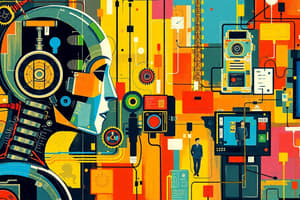Podcast
Questions and Answers
Which factor is NOT typically cited as a driver of the automation discourse?
Which factor is NOT typically cited as a driver of the automation discourse?
- The necessity of universal basic income to prevent mass-unemployment.
- Rising levels of technological unemployment.
- Increased global demand for specialized labor skills. (correct)
- The potential for collective liberation from toil through automation.
What concept did the Wall Street Journal use to describe a bill raising the minimum wage, reflecting concerns about automation?
What concept did the Wall Street Journal use to describe a bill raising the minimum wage, reflecting concerns about automation?
- The 'Guaranteed Income Initiative'.
- The 'Technological Advancement Act'.
- The 'Robot Employment Act'. (correct)
- The 'Human Capital Preservation Act'.
What is a key difference between techno-optimists like Ray Kurzweil and other proponents of the automation discourse regarding social transformation?
What is a key difference between techno-optimists like Ray Kurzweil and other proponents of the automation discourse regarding social transformation?
- Techno-optimists believe social transformation is necessary to achieve a utopian world, while others do not.
- Techno-optimists advocate for guaranteed non-wage income, unlike other proponents.
- Techno-optimists believe technological change alone will generate a utopian world without the need for social transformation. (correct)
- Techno-optimists focus on preventing mass-unemployment, while others prioritize universal basic income.
What do Erik Brynjolfsson and Andrew McAfee caution regarding the 'bounty' promised by automation?
What do Erik Brynjolfsson and Andrew McAfee caution regarding the 'bounty' promised by automation?
What 'frightening long-term scenario' does Martin Ford envision if the global economic system adapts to automation?
What 'frightening long-term scenario' does Martin Ford envision if the global economic system adapts to automation?
Which policy do figures like Bill Gates and Mark Zuckerberg advocate in response to automation?
Which policy do figures like Bill Gates and Mark Zuckerberg advocate in response to automation?
What do Nick Srnicek and Alex Williams argue is necessary to fully realize the potential of automation?
What do Nick Srnicek and Alex Williams argue is necessary to fully realize the potential of automation?
What is 'fully automated luxury communism,' and who originally coined the term?
What is 'fully automated luxury communism,' and who originally coined the term?
How does the text define 'automation' as distinct from other forms of labor-saving technical innovation?
How does the text define 'automation' as distinct from other forms of labor-saving technical innovation?
Which statement best summarizes the trend of automation in the history of capitalism, according to the text?
Which statement best summarizes the trend of automation in the history of capitalism, according to the text?
What key insight from economist Wassily Leontief does the text highlight in relation to automation theory?
What key insight from economist Wassily Leontief does the text highlight in relation to automation theory?
What factor does the text identify as summoning the automation discourse periodically into being?
What factor does the text identify as summoning the automation discourse periodically into being?
What long-held assumption about economic growth has been challenged by recent trends, as highlighted in the text?
What long-held assumption about economic growth has been challenged by recent trends, as highlighted in the text?
What does the author suggest leads to the 'upside-down world of the automation discourse'?
What does the author suggest leads to the 'upside-down world of the automation discourse'?
What is the author's perspective on whether automation is the primary cause of low labor demand?
What is the author's perspective on whether automation is the primary cause of low labor demand?
Which sector must automation affect to have significant social consequences?
Which sector must automation affect to have significant social consequences?
What trend in advanced economies is highlighted as a key factor related to manufacturing job losses?
What trend in advanced economies is highlighted as a key factor related to manufacturing job losses?
Which factor is NOT listed as a cause for job losses in advanced economies?
Which factor is NOT listed as a cause for job losses in advanced economies?
What is Robert Solow's 'productivity paradox'?
What is Robert Solow's 'productivity paradox'?
What does the text suggest about official US statistics from 1987 to 2011 regarding manufacturing productivity?
What does the text suggest about official US statistics from 1987 to 2011 regarding manufacturing productivity?
Which event had an average productivity growth of 6.3% per year in the 1950s and 60s, but has fallen to 2.4% since 2000.
Which event had an average productivity growth of 6.3% per year in the 1950s and 60s, but has fallen to 2.4% since 2000.
How do automation theorists characterize slower manufacturing rates?
How do automation theorists characterize slower manufacturing rates?
What accounting identity is used to explore deindustrialization?
What accounting identity is used to explore deindustrialization?
Which economic trend has led to rapid rates to be more difficult to achieve?
Which economic trend has led to rapid rates to be more difficult to achieve?
According to the test, which period saw Europe, the US and Japan's wealth converge?
According to the test, which period saw Europe, the US and Japan's wealth converge?
What is 'pre-industrialized deindustrialization?'
What is 'pre-industrialized deindustrialization?'
Which country is offered used in illustration of deindustrialization in China, India and Mexico?
Which country is offered used in illustration of deindustrialization in China, India and Mexico?
What is the rate of global manufacturing expansion from 2008 to 2014?
What is the rate of global manufacturing expansion from 2008 to 2014?
In countries that are deindustrializing, what steps do firms make in relation to their existing manufacturing capacity?
In countries that are deindustrializing, what steps do firms make in relation to their existing manufacturing capacity?
When did low cost Japanese and German goods invade the US domestic market?
When did low cost Japanese and German goods invade the US domestic market?
What is a key factor relating to US firms and multinational firms in the US seeing globalization of production as a response?
What is a key factor relating to US firms and multinational firms in the US seeing globalization of production as a response?
What types of products do sunbelts focus on?
What types of products do sunbelts focus on?
Why is it more cost effetive for countries that are not the worst degree of industrialized to have high degree of robotization?
Why is it more cost effetive for countries that are not the worst degree of industrialized to have high degree of robotization?
What factors has China advanced based on?
What factors has China advanced based on?
What trend has occurred along with countries that have deindustrialized?
What trend has occurred along with countries that have deindustrialized?
Which action did those in poorer countries pursue government encourage?
Which action did those in poorer countries pursue government encourage?
Which global trade is an important link to countries that are looking to sell to the international market?
Which global trade is an important link to countries that are looking to sell to the international market?
Flashcards
Lights-out production
Lights-out production
Fully automated work processes, needing no human hands, running in the dark.
Technological unemployment
Technological unemployment
Workers being displaced by advanced machines, causing rising unemployment.
Largely automated society
Largely automated society
A society where nearly all work is performed by self-moving machines and computers.
Automation & Human Liberation
Automation & Human Liberation
Signup and view all the flashcards
Universal Basic Income (UBI)
Universal Basic Income (UBI)
Signup and view all the flashcards
Automated feudalism
Automated feudalism
Signup and view all the flashcards
Automation technologies
Automation technologies
Signup and view all the flashcards
Automation
Automation
Signup and view all the flashcards
Labor-augmenting technologies
Labor-augmenting technologies
Signup and view all the flashcards
Automation's Impact
Automation's Impact
Signup and view all the flashcards
Anxiety in the labour market
Anxiety in the labour market
Signup and view all the flashcards
Deindustrialization
Deindustrialization
Signup and view all the flashcards
Robotization
Robotization
Signup and view all the flashcards
Manufacturing overcapacity
Manufacturing overcapacity
Signup and view all the flashcards
Globalizing production
Globalizing production
Signup and view all the flashcards
Pre-WW1 Era
Pre-WW1 Era
Signup and view all the flashcards
Lack of opportunities to rise in service sector jobs
Lack of opportunities to rise in service sector jobs
Signup and view all the flashcards
Study Notes
- Rapid advances in AI, machine learning, and robotics are poised to transform the world of work.
- Some businesses are aiming for "lights-out" production with fully automated processes, requiring no human intervention.
- Machines are developing capabilities like playing ping-pong, cooking, having sex, and holding conversations.
- Computers are learning to identify cancers and develop legal strategies, while self-driving trucks and weaponized robotic dogs are becoming a reality.
- There are beliefs that technology can cause mass unemployment.
- Providing a universal basic income (UBI) is a proposal to prevent mass-unemployment.
- Automation can result in growing inequality, where a greater share of annual income is captured by capital rather than labor.
- Guaranteed non-wage income, like a negative income tax, may be necessary.
- Figures like Bill Gates, Mark Zuckerberg, and Elon Musk have advocated for policies like taxing robots and exploring UBI.
- Politicians have identified with the automation discourse, suggesting that it could make many middle-class jobs obsolete.
- Automation discourse supporters take pains to insist capitalism will stay.
- Only a socialist government can fulfill the promise of automation by creating the post working society.
- Automation technologies replace human labor, rather than augment human-productive capacities
- During automation, an entire job class is eliminated.
- Automation is a constant feature of capitalism.
Recurrent fears
- Automation is a symptom of our era with the global economy failing to create adequate jobs.
- Current reality is a planet of extreme inequality where the rich live comfortably while others struggle in dead-end jobs.
- A post-scarcity world can serve as the foundation to address climate change and allow people to question, learn, and create.
Labour's Global Deindustrialization
- Automation theorists recognize the job destruction needs to eliminate a large range of service sector jobs to hold widespread ramifications.
- Manufacturing is seen as a precedent, where an employment-apocalypse has already taken place.
- Manufacturing is readily automated.
- The first industrial robot was installed in 1961.
- Manufacturing employment grew rapidly in areas of fast technical innovation, dropping prices and stoking demands
- These are the results of production facilities moving offshore.
- Real value added in manufacturing has more than doubled in many countries.
- Deindustrialization is most commonly defined as a decline in the share of manufacturing and total employment.
- The primary cause of industrial job loss in advanced economies is rapidly rising labor productivity.
Decline of Productivity
- Manufacturing productivity has grown at a slow pace for decades.
- Government statistics inflated productivity levels by counting products with higher processing power as more products.
- Manufacturing productivity rates have fallen dramatically since postwar peaks.
- In France, productivity growth rates in French manufacturing were much higher between 1950-1973, compared to current rates.
The Accounting Identity
- ΔΟ - ΔΡ = ΔΕ (Growth of output - productivity - growth in employment)
Blight of manufacturing overcapacity
- It is not only a matter of technological advancement, but global technology redundancy
- There are crowded markets.
- Rates of output growth in manufacturing have tended to decline worldwide;
- Rising manufacturing capacity created overcapacity, resulting in a 'long downturn' in output growth rates.
Driving Globalization
- Global waves of deindustrialization have originated in worsening overcapacity in world markets.
- The U.S. shared technology with former competitors to bring them under the U.S. Security Umbrella.
- Rising manufacturing capacity across the world lead to a long downturn in manufacturing output.
- Low-cost Japanese and German products invaded the U.S. domestic market in the 1960s, causing a decline in growth.
- Global deindustrialization is a result of global redudancy of technological capacities.
- Decreasing manufacturing prices caused a fall income per unit, fall in profits, and lower investment.
- There is heightened competition for market share.
- Rising overcapacity has been accompanied by efforts to develop new technological systems, and building new supply chains.
- The international supply chain causes cheap, low grade technology zones to open.
- The globalization of production allowed the richest economies to retain manufacturing, but not the overall trend.
- Rustbelts declined while Sunbelts expanded and integrated to global networks.
- Global manufacturing overcapacity explains countries attaining high degrees of robotization haven't seen the worst deindustrialization
Beyond Manufacturing
- Intense global competition and high degrees of robotization have given companies an edge, allowing firms to claim market share.
- High degrees of robotization help workers preserve their jobs.
- Worsening industrial stagnation causes wage stagnation, and falling incomes
- No economic system replaced manufacturing to shape global economic growth in the post colonial countries; lower export rates caused ignited the 1982 debt crisis, with countries deepening their global market.
- The lack of a better engine explains developing nations want to enter international markets.
- System-wide overcapacity and lower global growth have devastated poorer nations.
- Rapid workforce expansion between 1980-present means less job opportunity.
- A low demand for labor causes employment insecurities.
- Productivity growth rates aren't as high as technology suggests.
- Declines in the workforce are influenced by the gap in productivity and output growth rates.
Studying That Suits You
Use AI to generate personalized quizzes and flashcards to suit your learning preferences.




